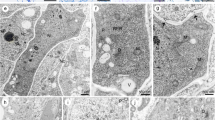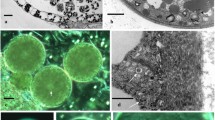Summary
The developing exine ofLycopodium gnidioides is traversed from the outer to the inner surface by a series of anastomosing channels filled or lined with fibrillar glycoprotein. When living sporangia are incubated in colloidal iron, particles of ferric iron can be detected in the exine channels, the intine and the spore cytoplasm, and some iron is retained by the surface coatings on the spore. Although there is some diffuse iron staining of the exine between the channels, the main concentration of particles is associated with these structures. This, together with the fact that the proximal lasurae of the spore are closed during development, is taken as evidence that the iron has passed from the locular fluid to the surface of the protoplast principally by way of the exine channels. Results obtained from fixation in a glutaraldehyde-lanthanum nitrate mixture support this interpretation. While the exine channels are in existence, therefore, the spore protoplast is in open communication with the locular environment. The study provides no evidence to suggest that the iron which entered the spore cytoplasm did so by endocytosis. It is possible that iron altered the permeability of the plasma membrane by damaging its structure; entry of iron to the cytoplasm being effected through the damaged membrane.
Similar content being viewed by others
References
Bennett, H. S., 1969 a: The cell surface: components and configurations. In: Handbook of molecular cytology, pp. 1261–1293 (A. Lima-de-Faria, ed.). Amsterdam-London: North Holland Publishing Company.
— 1969 b: The cell surface: movements and recombinations. In: Handbook of molecular cytology, pp. 1294–1319 (A. Lima-de-Faria, ed.). Amsterdam-London: North Holland Publishing Company.
Christensen, J. E., andH. T. Horner, Jr., 1974: Pollen pore development and its spatial orientation during microsporogenesis in the grassSorghum bicolor. Amer. J. Bot.61, 604–623.
— — andN. R. Lersten, 1972: Pollen wall and tapetal orbicular wall development inSorghum bicolor (Gramineae). Amer. J. Bot.59, 43–58.
Heslop-Harrison, J., 1975: The physiology of the pollen grain surface. Proc. roy. Soc. (Lond.) B190, 275–299.
—,Y. Heslop-Harrison, R. B. Knox, andB. Howlett, 1973: Pollen-wall proteins: “gametophytic” and “sporophytic” fractions in the pollen walls of theMalvaceae. Ann. Bot.37, 403–412.
Howlett, B. J., R. B. Knox, andJ. Heslop-Harrison, 1973: Pollen-wall proteins: release of the allergen Antigen E from intine and exine sites in pollen grains of ragweed andCosmos. J. Cell Sci.13, 603–619.
Ito, S., 1974: Form and function of the glycocalyx on free cell surfaces. Phil. Trans. (Lond.)B 268, 55–66.
Knox, R. B., 1971: Pollen-wall proteins: localization, enzymic and antigenic activity during development inGladiolus (Iridaceae). J. Cell Sci.9, 209–237.
— andJ. Heslop-Harrison, 1970: Pollen-wall proteins: localization and enzymic activity. J. Cell Sci.6, 1–27.
- - and Y.Heslop-Harrison, 1975: Pollen-wall proteins: localization and characterization of gametophytic and sporophytic fractions. In: The biology of the male gamete, pp. 177–187 (J. G.Duckett and P. A.Racey, eds.). Suppl.1, Biol. J. Linn. Soc. 7.
Pettitt, J. M., 1970: Heterospory and the origin of the seed habit. Biol. Rev.45, 401–415.
—, 1971: Some ultrastructural aspects of sporoderm formation in pteridophytes. In: Pollen and spore morphology/plant taxonomy. IV. Pteridophyta, pp. 227–251 (G. Erdtman andP. Sorsa, eds.). Stockholm: Almqvist and Wiksell.
—, 1974: Developmental mechanisms in heterospory. II. Evidence for pinocytosis in the microspores ofSelaginella. Bot. J. Linn. Soc.69, 79–87.
— andA. C. Jermy, 1974: The surface coats on spores. Biol. J. Linn. Soc.6, 245–257.
Reynolds, E. S., 1963: The use of lead citrate at a high pH as an electron opaque stain in electron microscopy. J. Cell Biol.17, 208–212.
Revel, J. P., andM. J. Karnovsky, 1967: Hexagonal arrays of subunits in intercellular junctions of the mouse heart and liver. J. Cell Biol.33, C 7–12.
Rowley, J. R., 1971 a: Resolution of channels in the exine by translocation of colloidal iron (C. J.Arceneaux, ed.). 29th Ann. Proc. E.M. Soc. Amer. Boston Mass.
— 1971b: Implications on the nature of sporopollenin based upon pollen development. In: Sporopollenin, pp. 175–218 (J. Brooks, P. R. Grant, M. D. Muir, P. van Gijzel, andG. Shaw, eds.). London: Academic Press.
— 1973: Formation of pollen exine bacules and microchannels on a glycocalyx. Grana13, 129–138.
— 1975: The permeability of the pollen grain wall to exogenous protein tracers. J. Ultrastruct. Res.50, 394.
Rowley, J. R., andA. Dunbar, 1970: Transfer of colloidal iron from sporophyte to gametophyte. Pollen Spores12, 305–328.
— andJ. J. Flynn, 1971: Migration of lanthanum through the pollen wall. Cytobiologie3, 1–12.
Spurr, A. R., 1969: A low-viscosity epoxy resin embedding medium for electron microscopy. J. Ultrastruct. Res.26, 31–43.
Author information
Authors and Affiliations
Rights and permissions
About this article
Cite this article
Pettitt, J.M. A route for the passage of substances through the developing pteridophyte exine. Protoplasma 88, 117–131 (1976). https://doi.org/10.1007/BF01280364
Received:
Issue Date:
DOI: https://doi.org/10.1007/BF01280364




